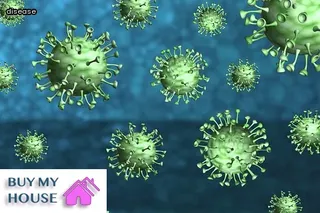Mold is a fungus that is found in a variety of different environments, both indoors and outdoors. It can grow on many different surfaces and materials, including wood, fabric, paper, carpet, insulation and even food.
Household mold often grows in damp or humid areas such as basements, attics and bathrooms. Mold spores are very small and light in weight.
They travel through the air and can easily become airborne if disturbed or exposed to wind or air currents. Exposure to mold can cause various health issues such as coughing, wheezing, congestion and skin irritation.
Some people may also experience more severe reactions such as allergic reactions or asthma attacks. It is important to inspect your home for signs of mold growth and take steps to reduce moisture levels to help prevent it from forming in the first place.

Identifying mold in your home is key to preventing or treating the health issues that can arise from exposure. It is important to understand the signs of mold in order to protect yourself and your family.
Mold can be found in any area where moisture is present, such as bathrooms, basements, and attics. Common warning signs include a musty odor, visible discoloration on walls or ceilings, and water spots.
If you suspect a problem but cannot see it, use a damp cloth to wipe away dust and dirt to search for mold growth. Additionally, if you have experienced any respiratory issues such as coughing or sneezing, you may want to get a professional inspection as these symptoms could be related to hidden mold growth.
The best way to prevent health issues caused by household mold is to keep your home dry and well-ventilated at all times.
Mold exposure can cause a variety of unpleasant and potentially dangerous symptoms. Short-term mold exposure can lead to nasal stuffiness, throat irritation, coughing or wheezing, eye irritation, or skin irritation.
Long-term exposure may cause more severe reactions such as fever and shortness of breath. As well as physical symptoms, many people report experiencing mental health issues such as anxiety and depression after mold exposure in their homes.
It is important to understand the signs of mold exposure so that you can protect your health by taking steps to avoid it. If you think you may have been exposed to mold, it is best to consult your doctor for advice on how to reduce your risk of serious illness from prolonged contact with household mold.

Mold exposure can be a serious health risk if left unchecked and undiagnosed. Over time, mold can create an unsafe environment in the home and cause long-term health problems such as respiratory illnesses, asthma attacks, and even more severe conditions like cancer.
Symptoms of long-term mold exposure can vary depending on the individual but may include headaches, dizziness, nausea, fever, rashes, coughing/wheezing fits, sinus infections/inflammation, throat irritation or pain, and difficulty breathing. It is important to be aware of these symptoms and take action if you think you may have been exposed to mold for an extended period of time.
Proper diagnosis from a medical professional is critical to ensure that any potential risks are addressed quickly and effectively.
Mold in the home can have serious consequences for health, with exposure to mold increasing the risk of developing a variety of physical and psychological illnesses. Mold growth often occurs due to insufficient ventilation or humidity control, inadequate cleaning and maintenance, water damage caused by flooding or plumbing problems, and structural issues such as cracks in walls or roofs.
Common causes of mold sickness include airborne spores, which are released into the air when mold grows on surfaces; inhalation of these particles leads to respiratory irritation and other symptoms. Additionally, contact with mold-infested fabrics or objects can cause skin irritation and rashes.
Long-term exposure to household mold can also trigger inflammation in the airways and lungs, leading to difficulty breathing and chest tightness. Understanding the signs and symptoms of mold exposure is key to preventing illness in your home.

When it comes to diagnosing and treating mold sickness, the first step is to be aware of the signs and symptoms of exposure. Common symptoms of mold exposure include coughing, sneezing, nasal congestion, itchy eyes, headaches, and difficulty breathing.
In some cases, these symptoms may be accompanied by fatigue and difficulty concentrating. If you are experiencing any of these symptoms after being exposed to mold in your home, it is important to seek medical attention right away.
Your doctor may recommend an allergy test or perform a physical exam to determine if the cause of your illness is related to mold or another environmental factor. Once the cause has been identified, a treatment plan can be developed that may include medication or other lifestyle changes such as improving air quality in your home by using air purifiers and dehumidifiers.
When it comes to treating severe cases of mold sickness, it is important to seek medical attention right away. Depending on the severity of the illness, treatment may include medications such as antibiotics or antifungals to combat the infection and reduce any inflammation caused by the mold.
Additionally, if the patient's environment is suspected of having high levels of mold, they should be relocated until it can be properly treated. In serious cases, hospitalization may be necessary in order to provide supportive measures such as oxygen therapy or intravenous fluids.
Finally, a removal and clean-up protocol should be implemented to completely eradicate any existing mold growth and prevent further exposure. All these treatments are designed to help restore health and wellbeing for those suffering from severe cases of mold sickness.

Cleaning up and preventing future mold growth is essential for protecting your home from the adverse health effects of long-term exposure. The first step in controlling mold growth is to identify the source of moisture that caused the mold to form.
This could be a leaky pipe, roof damage or water collecting in areas with poor ventilation. Once you have identified this source, it is important to make repairs to eliminate the cause and then clean up any existing mold with soap and water.
To prevent future mold growth, maintain low humidity levels (below 55%) and use dehumidifiers if needed. Make sure to regularly check your home for signs of water damage or leaks, especially in bathrooms, kitchens and basements where moisture can accumulate quickly.
Also make sure to inspect any insulation or walls that may have been exposed to moisture after a flood or plumbing leak. Taking these proactive steps will help keep your home safe and healthy by keeping mold at bay.
Testing for mold in your home is an important step to take if you suspect that your health is being affected by exposure. Although testing can be expensive, it is the only way to definitively determine whether household mold is making you sick.
Visual inspections are one of the most common ways to detect mold in your home and can be done easily and inexpensively. However, since some molds are not visible to the naked eye, it is important to use specialized equipment such as moisture meters, borescopes and infrared cameras.
These tools can help detect moisture buildup as well as any hidden pockets of mold growth. Make sure to follow proper safety protocols when performing a mold test on your own, such as wearing protective gear and avoiding contact with any visible mold colonies.
Professional testing may also be necessary if you suspect that the problem is more serious or widespread than initially thought. With an accurate diagnosis and treatment plan in place, you can finally get relief from the uncomfortable symptoms caused by household mold exposure.

When dealing with mold, it is essential to take necessary safety precautions in order to protect yourself and others from potential exposure. Before removing or cleaning up mold, it is important to wear protective clothing such as a long sleeved shirt, pants, shoes and socks, gloves, and a dust mask.
Additionally, it is recommended to open windows for ventilation when attempting to clean or remove mold. It is also beneficial to use a biocide product specifically designed for killing mold.
If you are using bleach for the removal of the mold, make sure that you are wearing the appropriate protective gear and ensure that you are in a well-ventilated area. Before vacuuming up any mold spores, it is important to purchase an HEPA filter vacuum cleaner and then dispose of the bag outside of your home after usage.
Lastly, make sure that all furniture or carpets affected by the mold are completely dry before bringing them back into your home.
Household mold can be a major source of indoor air pollution, and long-term exposure to high levels of mold can cause serious health issues. To reduce the risk of these health problems, it is important to take steps to prevent or minimize mold growth in your home.
If you suspect that your home may have a high level of indoor air pollution caused by mold, there are several things you can do to deal with the issue. First, identify the source of the problem; if possible, eliminate moisture sources such as leaks or flooding.
Second, regularly inspect your home for visible signs of mold growth and repair any water damage immediately. Lastly, use an air purifier or dehumidifier to reduce the amount of airborne mold particles in your home.
Following these tips will help keep you and your family safe from potential health risks associated with living in a home with a high level of indoor air pollution caused by household mold.

When it comes to toxic molds, prolonged exposure can have serious health consequences. Inhaling the spores of mold can cause inflammation in the lungs and airways, leading to respiratory issues like coughing and difficulty breathing.
Toxic mold exposure is also linked to a range of neurological symptoms, including headaches, dizziness, confusion, memory loss, and fatigue. Long-term exposure can even result in organ damage.
It’s important to understand that not all mold is considered toxic; however, certain species are known for producing mycotoxins which can be hazardous if inhaled or ingested. Exposure to these types of molds should be avoided as much as possible and proper safety measures should always be taken when cleaning or removing them from a home.
Molds are microscopic organisms that exist everywhere in nature, and although they often go unnoticed, they can have a significant impact on human health. They produce allergens, irritants, and in some cases, infections; all of which can cause serious health risks if left unchecked.
Exposure to molds has been linked to a variety of respiratory issues such as asthma, coughing, sneezing, nasal congestion, and other allergic reactions. In more severe cases, it can lead to eye irritation or even skin rashes.
Furthermore, mold exposure has been found to aggravate existing conditions like allergies or asthma and can potentially create new ones. To make matters worse, people who are already compromised due to weakened immune systems may be more susceptible than others when it comes to the pathogenic effects of molds on their health.
It's important for individuals to be aware of the signs and symptoms associated with mold exposure so that they can take the necessary steps to ensure their safety.
Are you feeling unwell, but can’t figure out why? Could it be something in your home that’s making you sick? Mold is a common allergen that can cause a variety of unpleasant symptoms. If you suspect household mold is making you ill, there are several signs and symptoms to look for.
Shortness of breath, coughing, sneezing, difficulty breathing, and headaches are all common symptoms of mold exposure. If you have asthma or allergies, excessive exposure to mold can make existing conditions worse.
Irritation in the throat and nasal passages are also common side effects of mold exposure. In some cases, skin irritation may occur as well as a general feeling of fatigue.
If these symptoms arise suddenly after moving into a new home or cleaning an area with mold present, it could be a sign that the mold is making you sick. It’s important to act quickly and take steps to reduce your exposure.

Household mold can cause a variety of illnesses, both minor and serious. The most common illnesses caused by exposure to household mold include upper respiratory problems such as coughing, wheezing, asthma attacks, and allergies.
Mold can also affect the skin and cause irritation or an allergic reaction. In more serious cases, exposure to certain types of mold can lead to infections in the lungs and sinuses, fatigue, memory loss, headaches, and fever.
Additionally, individuals exposed to high levels of mold over a long period of time may experience more serious symptoms such as difficulty breathing, joint pain, nausea, vomiting or even cancer. When it comes to health issues related to household mold it is important to recognize the signs and symptoms quickly so that you can prevent them from becoming worse.
If you're concerned that the mold in your home might be making you sick, it's important to understand the signs and symptoms of exposure. Common indicators of mold exposure include coughing and sneezing, as well as difficulty breathing, watery or itchy eyes, throat irritation, skin irritation, headaches, and fatigue.
If you experience any of these symptoms when spending time in a certain room in your house or during particular activities such as cleaning or dusting, then it's possible that you may be exposed to mold. Additionally, if you have an ongoing issue with musty smells or visible mold growth in your home, then this could also be a sign that there are dangerous levels of mold present.
Mold can grow anywhere indoors where there is moisture and organic material such as wood or drywall; common problem areas include basements, attics and bathrooms. To ensure your health and safety, consider having an indoor air quality inspection conducted by a professional to identify hidden sources of mold.
Mold is a common household problem, but if left unchecked it can make you sick. The exact timeline for how long it takes for mold to make you sick varies depending on the type of mold and the sensitivity of the individual exposed to it.
Some people may start to feel ill within minutes or hours of exposure while others might take days or weeks to experience signs and symptoms. People with allergies or existing breathing conditions are typically more affected.
Symptoms may include respiratory issues, headaches, fatigue, allergic reactions, asthma attacks and irritated eyes. If you think you may have been exposed to mold in your home, take action quickly by removing any visible mold and seeking medical advice right away.
To avoid potential health risks from mold exposure, regularly inspect your home for any signs of moisture build-up that could lead to mold growth and contact a professional if necessary.